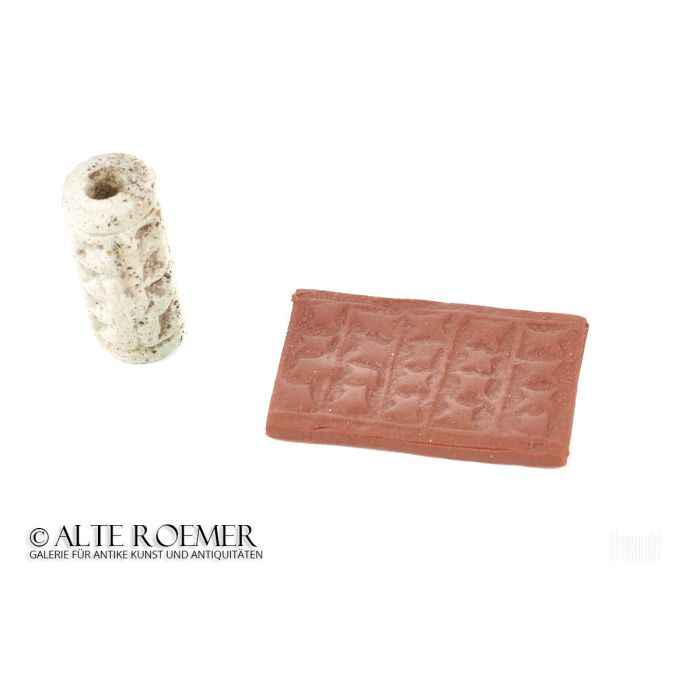Cylinder seal from the Jemdet Nasr period
€660
available
Object number
AR2959
| Object: |
Cylinder seal from the Jemdet Nasr period
|
| Material: |
Light faience.
|
| Period: |
3100 BC to 2900 BC, Jemdet Nasr period |
| Description: |
Cylindrical seal from Mesopotamia with through hole along the central axis. A geometrical arrangement of schematic representations is engraved into the mantle of the seal. The seal impression shows five columns, each with four cross-like shapes. These are schematic turtles or tadpoles.
|
| Background: |
Cylinder seals have been invented by the early civilizations of Mesopotamia. From the 4th Millenium BC onwards they conquered the whole Near East and beyond.
The emergence of this type of seal coincides with the first abundant use of scripture to manage the young highly organized city states. Such early seals are therefore a glimpse at the beginnings of civilization in Mesopotamia. Later seals broaden the view to all areas of administration, but also to trade and even personal matters. Many officials, traders and private persons must have possessed cylinder seals during the Bronze Age of Mesopotamia. What a happy instance for today's historians. Cylinder seals were made of durable materials and survived the millenia nearly unchanged. A treasury of images and inscriptions is reaching out to us from the Bronze Age. Thanks to the diverse original owners many stray finds have been made in the Near and Middle East. After the interest in antiquity has been reborn in Europe such finds have been preserved and valued. Many pieces could be attended to in private and public collections. And because of academic excavations with documented find contexts a chronology could be worked out. Today, also the stray pieces on the art market and in collections can be dated by iconographic means. For us it is a very special sensation to hold such seals in our hands and reflect the rise and fall of civilizations. |
| Dimensions: |
21mm length, 10mm diameter.
|
| Preservation: |
Near perfect condition. Only tiny chips, otherwise complete and intact.
|
| Provenance: |
Acquired by us in 2017 on the British art market. Previously in a London family collection. The piece was acquired for the collection in the 1970ies. It was inspected and described by Professor Lambert in the 1980ies. A copy of his notes is available. Wilfred George Lambert (1926 to 2011), a British archeologist specialized on Western Asia, was a professor at the University of Birmingham. After his retirement he was active in the ancient near eastern department of the British Museum. |
| References: |
Anton Moortgat, Vorderasiatische Rollsiegel: Ein Beitrag zur Geschichte der Steinschneidekunst (1988), nos. 41, 42, 53, 70.
|
| Authenticity: |
We guarantee the authenticity of this object and all works of ancient art sold by us for life.
|


